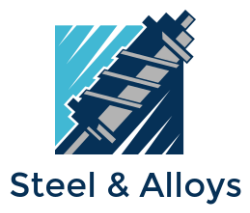Nitriding Steels
**Introduction to Nitriding Steels:**
Nitriding steels are a group of alloy steels known for their exceptional surface hardness, wear resistance, and improved fatigue strength after nitriding treatment. These steels contain elements like chromium, molybdenum, and aluminum, which enhance their response to nitriding processes. They find widespread applications in manufacturing components subjected to high wear and stress conditions, such as gears, shafts, and machine parts.
**Available Shapes and Sections:**
Nitriding steels are available in various shapes and sections to cater to diverse industrial needs. The most common shapes include rounds, squares, rectangular cross-sections (RCS), flats, hexagons, wire, and more.
**Size Range for Each Section:**
The size range of nitriding steel sections can vary depending on the steel grade and manufacturing process. Generally, the size range for each section is as follows:
- **Rounds:** Diameter ranging from 5mm to 300mm.
- **Squares:** Side length ranging from 5mm to 200mm.
- **Rectangular Cross-Sections (RCS):** Width ranging from 10mm to 200mm and thickness ranging from 5mm to 100mm.
- **Flats:** Width ranging from 10mm to 200mm and thickness ranging from 3mm to 100mm.
- **Hexagons:** Across flats ranging from 5mm to 100mm.
- **Wire:** Diameter ranging from 1mm to 20mm.
**Production Routes:**
The production routes for nitriding steel sections can significantly impact their properties and performance. Some common production routes include:
1. **Non-Vacuum Degassed Route:** This route involves the conventional steelmaking process without vacuum degassing. The steel produced through this route may have certain impurities and inclusions but is often more cost-effective.
2. **Vacuum Degassed Route:** In this route, the steel is subjected to vacuum degassing to remove impurities, resulting in higher purity and improved mechanical properties.
**Forms and Machinable Conditions:**
Nitriding steels are available in various forms and machinable conditions, each suited for specific applications.
1. **As Rolled:** As-rolled nitriding steels retain the properties acquired during hot rolling and are commonly used when the final application does not require precise tolerances.
2. **Annealed:** Annealing is a heat treatment process that improves the machinability and removes internal stresses in the steel, making it easier to work with.
3. **Normalized:** Normalizing the steel enhances its strength and hardness while ensuring uniformity in the microstructure.
4. **Spheroidize Annealed:** Spheroidized annealing increases the machinability and formability of the steel by producing a globular microstructure.
5. **CHQ (Cold Heading Quality):** CHQ steel is suitable for cold heading operations, making it ideal for the production of fasteners and other cold-formed components.
**Conclusion:**
Nitriding steels like EN-40A, EN-40B, EN-41A, EN-41B, and others offer excellent mechanical properties and surface hardness after undergoing nitriding treatment. Their availability in various shapes, sections, and machinable conditions makes them versatile for a wide range of industrial applications. Whether you need high-wear resistance or improved fatigue strength, nitriding steels have got you covered!
